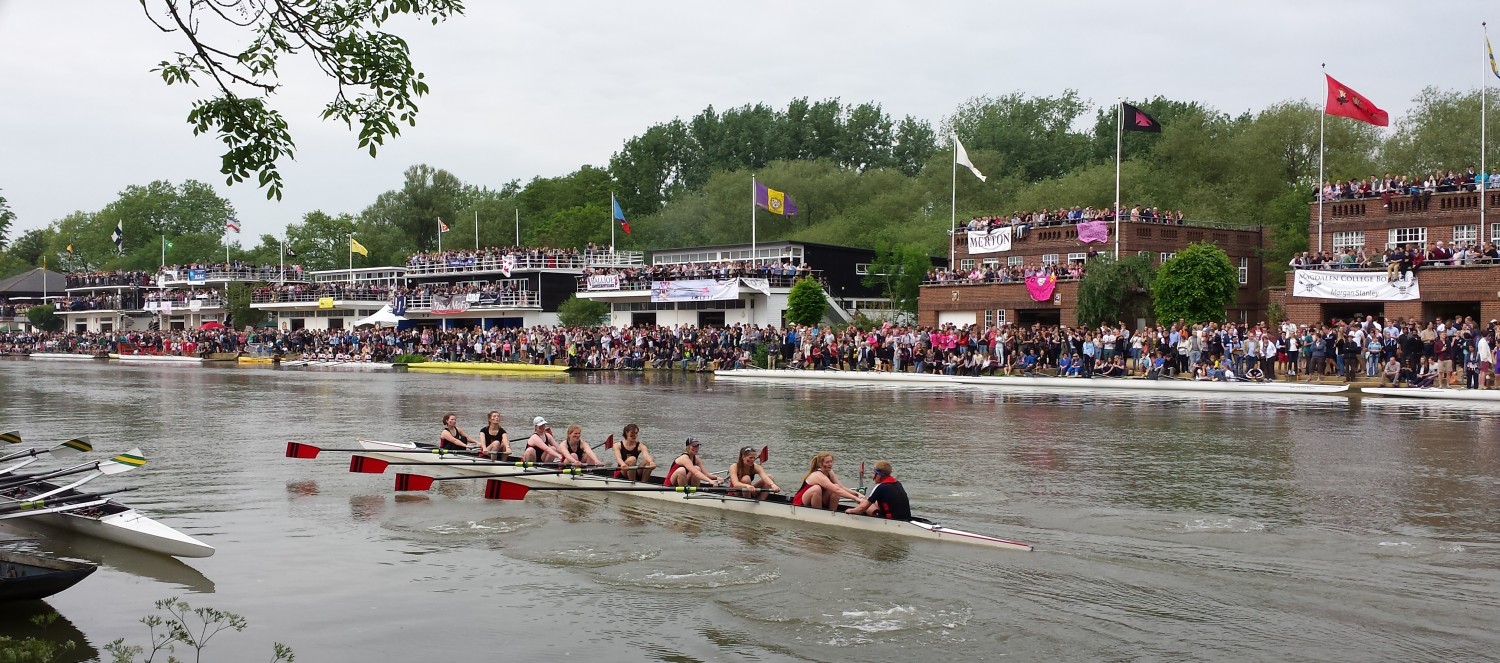Coaching “The Drive” – by Howard Aiken
(This is the second in a series of coaching notes. You may find it helpful to read it with the preceding “Coaching the Catch”).
The “Drive” is the ‘working’ phase of the rowing stroke. If we consider the four phases of the stroke (catch, drive, finish, recovery), the drive differs from the others in that it is as much about power as technique. The drive is the application of force to the handle of the blade to lever the boat past the spoon. That said, the quality of a good drive in the boat depends on how it begins at the catch and ends at the finish, and there are several different opinions as to what should happen in between.
- The muscles powering the drive
The most important point to be made about the drive concerns the fundamental sources of its power. These are your leg muscles, the same muscles you would use for jumping. This is important, because rowers tend to be more aware of “effort” than “output” and so tend to see the power available from legs, body and arms as more evenly matched than they actually are.
Your leg muscles contain a high proportion of fast “twitch” fibres which can deliver the rapid acceleration required for running and jumping. The simple fact that your leg muscles can be used to jump off the ground means that they are, on their own, able to accelerate however many tens of kilos your body weighs to over 9.8 metres per second per second (the acceleration due to gravity) – and they can do that even if you aren’t a trained athlete.
This is a huge amount of power and more to the point it is an amount of power that your back and arm muscles are completely incapable of delivering. You could test this for yourself, although I would not recommend it, by attempting to “jump” your whole body into the air from a pull-up or by using your back muscles. Arm muscles are fast, but lack the power of the legs. Your back muscles are very strong but contain far fewer fast fibres and more slow fibres suited to maintaining body posture.
Leg power is therefore the foundation of a good drive. There may be different opinions on how we build on that foundation, but all coaches will agree that without the legs there is no drive.
For those interested in the anatomical detail, there is a useful summary of the muscles used in jumping here:
https://www.reference.com/science/muscles-used-jumping-607a6a7a73ad634c#
When we jump, knee extension and hip extension occur simultaneously. We unbend (extend) knee and hip joints at the same time to launch ourselves into the air. Similarly in rowing, the drive involves forcefully straightening the knees and opening the angle between the thighs and the trunk. However, in rowing, while we are using mostly the same muscles, we differ in the sequence in which they are used.
The difference can perhaps be summed up best in the following diagrams, showing how both the knee angle (K) and the hip angle (H) open during the stroke:
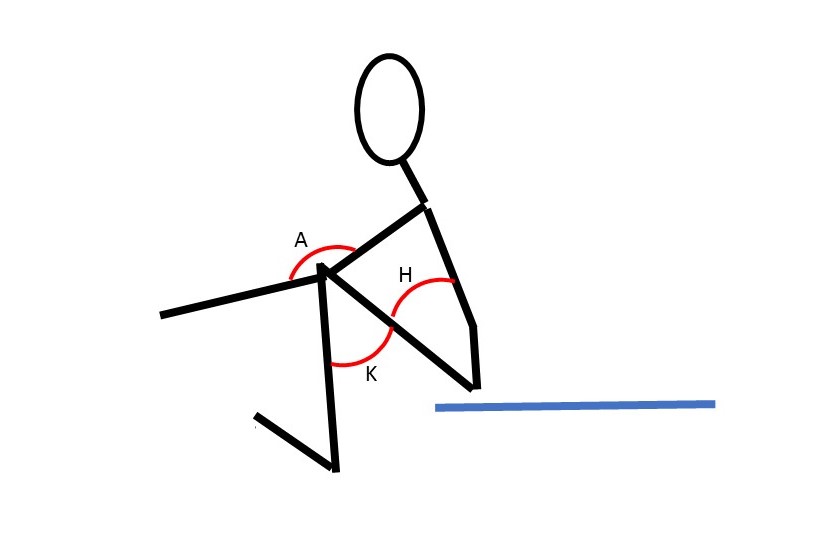
Figure 1. Catch Position
In the catch position (Figure 1) the rower is compressed into frontstops with the legs flexed at the knees and the body flexed at the hips. We have acute angles at both the knee (K) and hips (H) while the arms are at their longest (A). In a normally rigged boat, the rower’s heels will be raised off the footplate to maximise the length of the stroke and the pressure on the footplate at the start of the drive will applied through the balls of the feet.
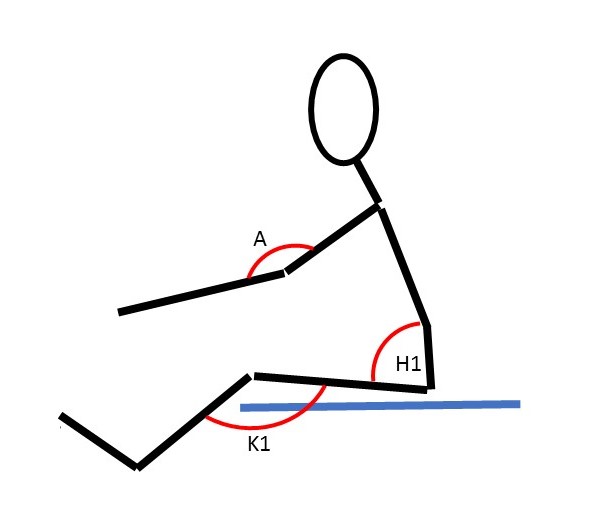
Figure 2. Drive Position
During the drive the rower executes a sequence of movements. First, the knees extend, opening the angles at the knee (K1) and hip (H1). The arms remain extended, so their angle at the elbow (A) remains unchanged. As the knees extend the heels come down onto the footplate to support the drive.
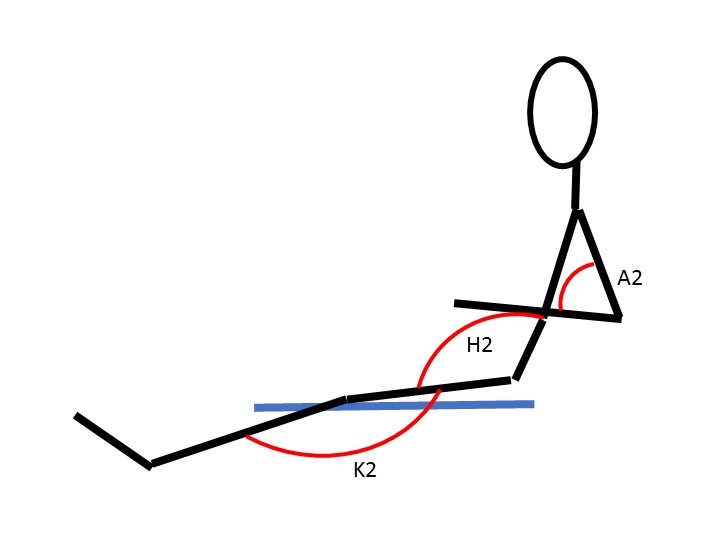
Figure 3. Finish Position
Next the rower leans back, opening the hip angle further (H2). Lastly, the arms are used, drawing the stroke through to the chest and closing the angle at the elbow (A2). At the finish position the knees are fully extended and hips partly extended (at full extension the rower would be lying down in the boat).
The sequence ‘legs, body, arms’ is fundamental, but there are different schools of thought as to how soon during the drive the body should be used. I favour late use of the body, mainly because it helps rowers to focus their effort on maximising use of the legs and therefore of the exceptional power they provide to the stroke.
- Common errors during the drive
2.1 Early use of the back. A common novice error (particularly with older novices) is to combine the use of the legs and body, swinging the upper body back as soon as the catch is taken. This error synchronises the knee extension to the hip extension, very much as they synchronise when we jump. The knees take longer to extend and the force applied to the blade – particularly in the early part of the drive – is therefore reduced. Sometimes, when you ask such rowers to stop using their bodies and arms and row ‘legs only’, rather than driving the slide to backstops position, their leg drive stops after just a few centimetres at the point when they would start using their backs – showing that they are not making full use of their legs.
In my view, if as a coach you can get rowers to focus on delivering the full power of their legs for the full length of the slide you have a good basis on which to build a powerful stroke.
A rower’s back needs to be strong enough to transmit this power from the legs to the arms. This is not always the case with younger rowers who sometimes have a tendency during the drive to let the legs push the slide back faster than their upper bodies. Their hip angle tends not to open as the knee angle opens (an error we call “bum-shoving” in the UK).
This situation becomes reversed with older rowers, ex-rugby players and others whose upper-body strength is proportionally greater than that of their legs. They will tend to use their backs early in the stroke and will under-use their legs. That is not to say that they don’t get to backstops, but they lose the legs-body-arms sequence and use their backs rather than their legs as the main driver of their stroke.
2.2 Early use of the arms is another novice error. Novice rowers often focus on the movement of the blade rather than the movement of their bodies and in their anxiety to move the blade at the catch they use their arms to pull on it rather than pushing with their legs. As was pointed out earlier, the arms can deliver only a fraction of the power available from the legs, so it is important to encourage these rowers to apply pressure on the footplate as the best way to move the boat.
While the arms are fully extended during most of the drive they are working under tension and their muscle strength is not a factor in the power of the first part of the stroke. I often tell rowers to imagine their outside arm (the arm connecting the shoulder to the end of the handle) as a rope with a hook on the end. Its muscles are not used until the legs and body have done most of the work. Early use of the arms will actually reduce the amount of power applied to the handle in the first part of the stroke because the amount of weight (or pull) which can be supported by the flexed arm is limited by the strength of the flexing muscles – mainly the biceps, whereas the amount of weight which can be supported by the extended arm is limited by its tensile strength, which is far greater.
- Blade depth
While there is at least a partial consensus on the good and bad technique in terms of body position (more on this later) there are a variety of views on the most efficient use of the blade. My personal preference as a coach of club and college rowers, is to encourage them to use the carefully engineered buoyancy of the blade as their guide to blade depth during the drive. In other words, I coach my rowers to let the squared blade float in the water at its ‘natural’ depth. Other coaches argue that more efficient transmission of force to the water is achieved by planting the spoon deeper so that its top edge is 4 to 5 centimetres below the surface during the drive. This may well be effective for elite scullers, but I think the video evidence from our best rowers shows that they work with the buoyancy of the blade to set the correct depth. Watch this video for example from 3:09 to 3:19 (unfortunately the IOC only allow us to watch this on YouTube).
- Washing out”
At the end of the drive as the rowers lean back and use the power of their arms to bring the handle toward their body, some rowers to pull the handle down into their laps or sometimes even to their upper thighs. This has the effect of bringing the spoon up out of the water before the stroke is finished, producing a telltale “wash” of agitated water on the surface rather than a deep “puddle” of swirling water at the finish. It also has the effect of lowering their rigger, upsetting the balance of the boat. I will cover the finish in more detail in another blog, but for the purposes of coaching a good drive, the way to avoid this error is to ensure that the spoon remains floating at its designed depth until the handle is almost at the rower’s chest at which point the outside hand taps down to extract the blade cleanly (with a minimum of splash) from the water.
- Variations in drive technique
A comprehensive survey of the various techniques taught for the drive is beyond the scope of this blog, but luckily, for those who are interested, there are some useful summaries available online. This paper by Theo Körner:
http://www.worldrowing.com/uploads/files/3Chapter2.pdf
dates from the early 1990’s and compares what were then known as the GDR (East German) and the Adam (West German) style. The Adam style dates from the 1960s and encourages rowers to use their backs earlier than we would today. The GDR style is much closer to modern techniques and emphasises an early leg drive followed by later use of the back.
Another paper by Dr. Valery Kleshnev on the biomechanics of rowing outlines two further variations, the Rosenberg style (from the USA) and the Grinko style (from the former USSR)
http://www.biorow.com/Papers_files/2006%20Rowing%20Biomechanics.pdf
see his figure 11 on page 16 reproduced here:

Kleshnev analyses these four styles in terms of their relative emphasis on leg or trunk musculature and their tendency toward simultaneous or consequent timing. He then shows typical power curves for each style – his figure 12 page 16 reproduced here:
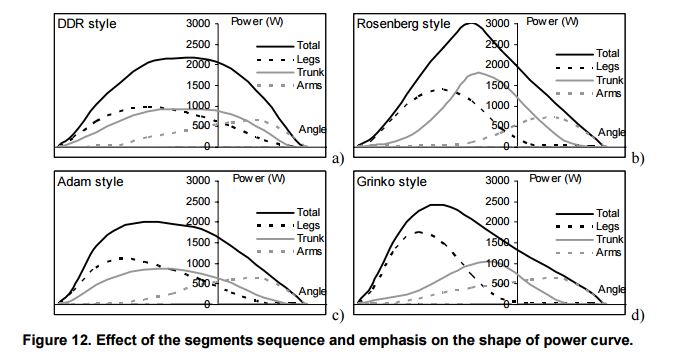
He makes the following point which I find interesting: “Styles with the trunk emphasis (Rosenberg and DDR styles) produce more power because of better use of big muscle groups as the gluteus and longissimus muscles. However, these muscles are congenitally slow because they are intended to maintain body posture”
I don’t know how Kleshnev measured the different contributions of legs, arms and trunk but the overall shape of the Grinko style curve (d) in the figure above is closest to my view of the ideal for a well-trained rower. Peak power is delivered early by the legs, with the trunk and arms becoming effective later in the drive.
The shaping of the power curve is of course best rehearsed on a rowing machine where the rower gets immediate visual feedback on its shape.
While as I have said, the drive phase of the rowing stroke is more about power than technique, it is not without its subtleties and coaches continue to experiment in pursuit of more efficiently applied effort and greater boat speed.
